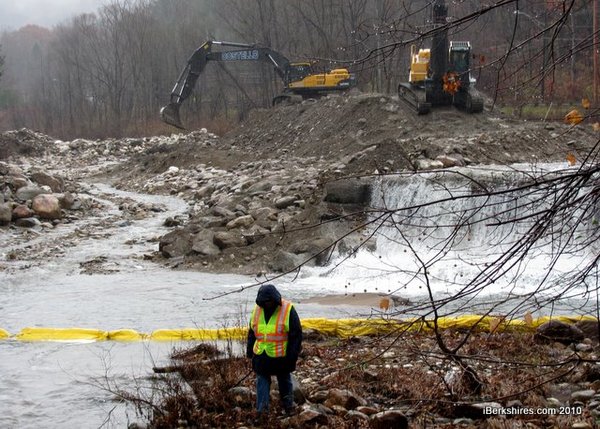
Briggsville Dam Deconstruction at Halfway Mark
 |
"It's been six years coming to fruition and now that it finally has, it's a tremendous relief," said Peter Cote, president of Cascade School Supplies, on Thursday morning. "As the president of Cascade, to have this fiscal risk to our company taken care of essentially by these great partners at the private, state and federal level, we couldn't be more pleased."
Cote was standing in the cold rain with representatives from some of those partners — the town of Clarksburg, the state Division of Ecological Restoration, the U.S. Fish & Wildlife Service, Eastern Brook Trout Joint Venture, Wildlife Conservation Society, Trout Unlimited, the Hoosic River Watershed Association and American Riverways — watching two payloaders pile sediment and rocks to split the Hoosic River.
The eastern side of the 150-foot long dam is gone and the eastern side nearly so. There was an expectation of seeing a section of dam knocked out Thursday but the preparation wasn't quite ready and the heavy rain added to the difficulty.
Work started a few weeks ago but there's still several weeks of work ahead, said James G. MacBroom of Milone & MacBroom Inc. of Cheshire, Conn., the engineer of record for the project. This coming spring, the river banks will be restored and planted.
The work began more than a year ago with assessment of the structure and the development of construction plans (or really, deconstruction plans). The result, said MacBroom, was a choreographed plan for contractor Costello.
"He's always going back and forth between three different things: one is making sure there's a channel to keep the water flowing; the second part is actually moving the dam piece by piece, and the third major element, which is the biggest part of the work, is removing all the sand and gravel that's accumulated in the pool itself," he said. "People may not realize it but behind the dam, the pool was almost totally full of sand and gravel, right up to the top ... it really didn't contain water."
Once completely removed, the Hoosic River will run free for 30 miles, allowing native fish like brook trout and longnose sucker to swim and spawn along its length.
"It will create a more stable population," said Dana Ohman, an aquatic biologist with the state's Division of Fisheries and Wildlife, who's overseen the removal of fish from the work site. "We're here for the smaller ones that can't get out."
The Briggsville Dam was designated a hazard since the state did a risk assessment of its 3,000 dams six years ago, prompted by the condition of the Taunton Dam after a record October rainfall. While the Office of Dam Safety has been involved with some removals, the state's Division of Ecological Restoration has done a half-dozen or so removals in partnership with local and state river organizations.
 Some of those involved in the removal of the dam, including James MacBroom, Jessica Clark and Nick Wildman, at right pose at the site. |
It's also involved in the removal of the Thunder Brook Dam in Cheshire and the Old Berkshire Mill Dam on the Housatonic River in Dalton.
Cote said he didn't realize Cascade, which occupies the old Strong Hewat Woolen Mill, owned the dam until the Office of Dam Safety contacted him about having it inspected. It was found to be in significant disrepair with a price tag of $600,000 to fix it.
"We didn't have that kind of money. This is a tremendous relief for Cascade," he said. "It takes the burden off our company and ensures our fiscal stabilitiy for years to come."
The dam once powered the woolen mill but like many old dams from the 19th and early 20th century is no longer suitable as an energy source, said MacBroom. "Today, the dams don't have an economic or commercial use; they become just a block to the flow of the water and a block to the organisms so you have to kind of balance historic value versus future value of the river."
Rather than being electrical generators, older dams spun waterwheels or turbines for mechanical power.
"It's much more efficient and much more economical to use electrical engines and so the dam doesn't really have any economic or social use anymore," he said. "While we like to encourage people to have green energy and renewable sources of energy, unfortunately, a lot of these old dams are in poor condition and are not a good candidate because of the environment and cost."
With the hazard gone, Cote's looking forward to better fishing along the river next summer. "They stock it here, you know, they fish here all summer long."
Related Stories:
|















